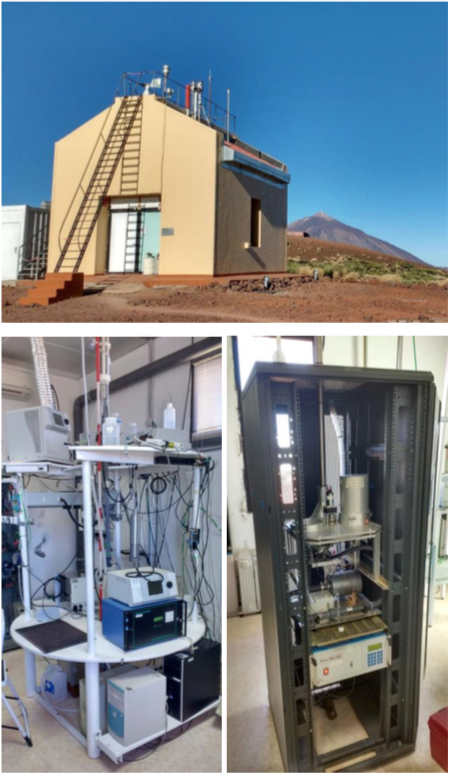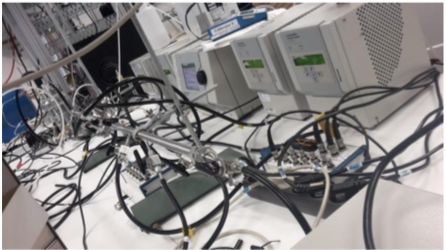Main Scientific Goals
Atmospheric aerosol is constituted by a mixing of natural (e.g. sea salt, desert dust or biogenic material) and anthropogenic (e.g. soot, industrial sulphate, nitrate, metals or combustion linked carbonaceous matter) airborne particles whose size range from a few nanometres (nm) to tens of microns (μm). Aerosols impair air quality with impacts on human health due to cardiovascular, cerebrovascular and respiratory diseases such as asthma and chronic obstructive pulmonary disease; they also influence climate by scattering and absorbing radiation and by influencing cloud formation and rainfall.
The activities of the In situ Aerosols programme are developed within the scientific priorities of the Global Atmosphere Watch programme. One of the main tasks of our group is to maintain the long-term observations of aerosols at IZO. These measurements improve the understanding of the potential long-term multi-decadal changes and trends of aerosols. Our investigations are focused on: 1) Long-term multi-decadal variability and trends of aerosols; 2) Aerosols and climate and 3) Aerosols and air quality.
Measurement Programme
The long-term in situ aerosols observation program of Izaña Atmospheric Observatory includes measurements of aerosol mass and number concentrations, chemical composition, size distribution and optical properties by in- situ techniques. Instruments are placed in the so-called Aerosols Research Laboratory (ARL) renamed as the Joseph M. Prospero Aerosols Research Laboratory, as a tribute to the pioneer of dust research, in 2016. The laboratory is equipped with a whole air inlet for conducting the aerosol sample to the on-line analysers (CPCs, SMPS, APS, MAAP, aethalometer, nephelometer), two additional PM10 and PM2.5 inlets for the aerosol filter samplers and also two additional inlets for TEOM (PM10 and PM2.5) and BETA (PM10) analysers respectively.

Joseph M. Prospero Aerosols Research Laboratory at Izaña Atmospheric Observatory (upper panel: building; lower panel: part of the instrumentation inside).
The interior of the Aerosols Research Laboratory is maintained at 22 oC. Because of the low relative humidity (RH) in the outdoor ambient air (RH percentiles 25th, 50th and 75th are 15%, 31% and 55%, respectively) driers are not needed. Measurements of number concentration, size distributions and optical properties of aerosols are performed with high time resolution.
For these automatic instruments, the QA/QC activities include:
- <daily checks> of the data and status of the instruments.
- <weekly checks> of the airflows and leak tests for some instruments (e.g. SMPS).
- quarterly checks> includes measurements of the instrumental zero (24h filtered air) for all the instruments (CPCs, SMPS, APS, MAAP, aethalometer nephelometer) and calibration checks (e.g. nephelometer).
- <annual intercomparisons> for some instruments.
- participation in intercomparisons, e.g. those performed annually between 2010 and 2012 for CPCs and SPMS at El Arenosillo – Huelva (Gómez-Moreno et al., 2011, 2013) and those in the World Calibration Centre for Aerosols Physics (WCCAP) in Leipzig – Germany for CPCs (Sep 2012) and absorption photometers (Nov 2005; Müller et al., 2011).
The procedure for these activities follows the recommendation of the GAW programme for aerosols.
In October 2017, the instruments of the ARL (SMPS, CPCs, MAAPs, nephelometres and aethaloemter) were recalibrated at the WCCAP in Germany. All devices obtained the calibration certificate. These procedures allow the long-term aerosol records at IZO to be traced to the international reference standards.

CPCs of Izaña during the calibration activities at the WCCAP in October 2017.
The aerosols chemical composition programme is based on:
- the collection of aerosol samples on filters. Samples are collected at night to avoid the diurnal upslope winds that may bring material from the boundary layer,
- the determination of the aerosol mass concentrations by the gravimetric method. Filters are weighed, before and after sampling, at 20 oC temperature and 30-35 % relative humidity in the Aerosol Filters Laboratory of the Izaña Atmospheric Research Centre . The procedure for weighing filters is similar to that described in EN-14907, except that we use a lower relative humidity (30-35 %) due to the relative humidity of the ambient air at IZO being much lower than the 50% stated by EN-14907.
- the determination of chemical composition which currently includes elemental composition (those detected by IPC-AES, i.e. Al, Ca, Fe, Mg, K, Na,…), salts (SO42-, NO3-, NH4+, Cl-), organic carbon, elemental carbon and trace elements (those detected by IPC-MS, i.e. P, V, Ni, Cd, As, Sb, Sn,…).
The QA/QC procedure for the aerosol chemical composition programme includes:
- airflow checks and calibrations.
- the collection of blank field filters for gravimetryand chemical analysis.
- intercomparison exercises.
For the QA/QC activities, the group is equipped with four bubble flow-meter GilibratorsTM for measuring airflows from a few to tens of litres per minute (e.g. CPCs, SMPS, APS, MAAP, aethalometer nephelometer) and three pressure drop flow-meters for measuring airflows of tens of cubic metres per hour .
The World Calibration Centre for Aerosol Physics audited the IZO aerosol programme in Nov 2006 (Tuch and Nowak, 2006). An updated report dated March 2014 is available .
Participation in Scientific Projects and Studies/Experiments
Additional activities included the participation in the first epidemiological study of exposure to ultrafine particles in urban areas of Spain, based on records in Santa Cruz de Tenerife, Huelva and Barcelona cities (Tobias et al., 2017). This study used a data set obtained in previous research projects led by the IARC team, which had focused on the sources (Fernández-Camacho et al., 2015; Gonález et al., 2011; González and Rodríguez, 2013; Rodríguez et al., 2007) and the impact of ultrafine particles on cardiovascular disease (Domínguez-Rodríguez et al., 2011, 2015, 2016).
The in-situ aerosols research group has also contributed to studies on ultrafine particles formation (Alonso-Blanco et al., 2018), on the influence of the topography of atmospheric observatories (Collaud Coen et al., 2018) and scattering properties of aerosol particles within the framework of the ACTRIS network (Pandolfi et al., 2018).
During this period, some of the previous cited activities where developed within the framework of the project AEROATLAN (CGL2015-66299-P) funded by the Ministry of Economy and Competitiveness of Spain and the European Regional Development Fund.
References
Alonso-Blanco, E., G mez-Moreno, F.J., Art ano, B., Iglesias- Samitier, S., Juncal-Bello, V., Pi eiro-Iglesias, M., L pez- Mah a, P., P rez, N., Brines, M., Alastuey, A., Garc a, M.I., Rodr guez, S., Sorribas, M., del guila, A., Titos, G., Lyamani, H., Alados-Arboledas, L. Temporal and spatial variability of atmospheric particle number size T distributions across Spain. Atmospheric Environment 190, 146–160, 2018.
Castillo, S., A. Alastuey, E. Cuevas, X. Querol, A. Avila: Quantifying Dry and Wet Deposition Fluxes in Two Regions of Contrasting African Influence: The NE Iberian Peninsula and the Canary Islands, Atmosphere, 8, 5, 86; doi:10.3390/atmos8050086, 2017.
Collaud Coen, M., Andrews, E., Aliaga, D., Andrade, M., Angelov, H., Bukowiecki, N., Ealo, M., Fialho, P., Flentje, H., Hallar, A. G., Hooda, R., Kalapov, I., Krejci, R., Lin, N.-H., Marinoni, A., Ming, J., Nguyen, N. A., Pandolfi, M., Pont, V., Ries, L., Rodríguez, S., Schauer, G., Sellegri, K., Sharma, S., Sun, J., Tunved, P ., V elasquez, P ., and Ruffieux, D.: Identification of topographic features influencing aerosol observations at high altitude stations, Atmos. Chem. Phys., 18, 12289-12313, https://doi.org/10.5194/acp-18-12289-2018, 2018.
Cuevas, E., Gómez-Peláez, A.J., Rodr guez, S., Terradellas, E., Basart, S., Garc a, R.D., Garc a, O.E., Alonso-Pérez, S. The pulsating nature of large-scale Saharan dust transport as a result of interplays between mid-latitude Rossby waves and the North African Dipole Intensity. Atmos. Environ. 167, 586-602, 2017.
Dom nguez-Rodr guez, A., Abreu-Afonso, J., Rodr guez, S., Ju rez-Preda, R.A., Arroyo-Ucar, E., Jim nez-Sosa, A., Gonz lez, Y., Abreu-Gonz lez, P., Avanzas, P., 2011. Comparative study of ambient air particles in patients hospitalized for heart failure and acute coronary syndrome. Rev. Esp. Cardiol. 64, 661–666.
Dominguez-Rodriguez, A., Rodr guez, S., Abreu-Gonzalez, P., Avanzas, Juarez-Prera Ruben A. Black carbon exposure, oxidative stress markers and major adverse cardiovascular events in patients with acute coronary syndromes. International Journal of Cardiology 188, 47–49, 2015.
Dominguez-Rodriguez, A., Juarez-Prera, R.A., Rodr guez, S., Abreu-Gonzalez, P., Avanza, P. Influence of meteorological conditions on hospital admission in patients with acute coronary syndrome with and without ST-segment elevation: Results of the AIRACOS study. Medicina Intensiva, 40, 4, 201- 207, 2016.
Fernández-Camacho, R., Brito Cabeza, I., Aroba, J., Gómez- Bravo, F., Rodríguez, S., de la Rosa, J. Assessment of ultrafine particles and noise measurements using fuzzy logic and data mining techniques. Science of the Total Environment 512–513, 103–113, 2015.
García, M. I., van Drooge, B. L., Rodríguez, S., and Alastuey, A.: Speciation of organic aerosols in the Saharan Air Layer and in the free troposphere westerlies, Atmos. Chem. Phys., 17, 8939- 8958, https://doi.org/10.5194/acp-17-8939-2017, 2017a
García, M. I., Rodríguez, S., and Alastuey, A.: Impact of North America on the aerosol composition in the North Atlantic free troposphere, Atmos. Chem. Phys., 17, 7387-7404, https://doi.org/10.5194/acp-17-7387-2017, 2017b.
Gonz lez, Y., Rodr guez, S., Guerra Garc a, J.C., Trujillo, J.L., Garc a, R., 2011. Ultrafine particles pollution in urban coastal air due to ship emissions. Atmos. Environ. 45, 4907–4914.
Gonz lez, Y., Rodr guez, S. A comparative study on the ultrafine particle episodes induced by vehicle exhaust, a crude oil refinery and ship emissions. Atmospheric Research 120–121, 43–54, 2013.
Gómez-Moreno, F.J., Alonso, E., Artíñano, B., Juncal-Bello, V., Iglesias-Samitier, S., Piñeiro Iglesias, M., López Mahía, P., Pérez, N., Pey, J., Ripoll, A., Alastuey, A., de la Morena, B.A, García, M.I., Rodríguez, S., Sorribas, M., Titos, G., Lyamani, H., Alados-Arboledas, L., Latorre, E., Tritscher, T., Bischof, O.F. Intercomparisons of Mobility Size Spectrometers and Condensation Particle Counters in the Frame of the Spanish Atmospheric Observational Aerosol Network. Aerosol Science and Technology, 49, 9, 2015.
Pandolfi, M., Alados-Arboledas, L., Alastuey, A., Andrade, M., Angelov, C., Artiñano, B., Backman, J., Baltensperger, U., Bonasoni, P., Bukowiecki, N., Collaud Coen, M., Conil, S., Coz, E., Crenn, V., Dudoitis, V., Ealo, M., Eleftheriadis, K., Favez, O., Fetfatzis, P., Fiebig, M., Flentje, H., Ginot, P., Gysel, M., Henzing, B., Hoffer, A., Holubova Smejkalova, A., Kalapov, I., Kalivitis, N., Kouvarakis, G., Kristensson, A., Kulmala, M., Lihavainen, H., Lunder, C., Luoma, K., Lyamani, H., Marinoni, A., Mihalopoulos, N., Moerman, M., Nicolas, J., O’Dowd, C., Petäjä, T., Petit, J.-E., Pichon, J. M., Prokopciuk, N., Putaud, J.-P., Rodríguez, S., Sciare, J., Sellegri, K., Swietlicki, E., Titos, G., Tuch, T., Tunved, P., Ulevicius, V., Vaishya, A., Vana, M., Virkkula, A., Vratolis, S., Weingartner, E., Wiedensohler, A., and Laj, P.: A European aerosol phenomenology – 6: scattering properties of atmospheric aerosol particles from 28 ACTRIS sites, Atmos. Chem. Phys., 18, 7877-7911, https://doi.org/10.5194/acp-18-7877-2018, 2018.
Rodríguez, S., Van Dingenen, R., Putaud, J.-P., Dell’Acqua, A., Pey, J., Querol, X., Alastuey, A., Chenery, S., Ho, K.-F., Harrison, R., Tardivo, R., Scarnato, B., Gemelli, V., 2007. A study on the relationship between mass concentrations, chemistry and number size distribution of urban fine aerosols in Milan, Barcelona and London. Atmos. Chem. Phys. 7, 2217– 2232, 2007.
Rodríguez, S. Updated report of the in-situ aerosol program at Izaña, and feedback to the WCCAP report of the November 2006 audit. March 2014, 2014. http://www.wmo-gaw-wcc- aerosol-physics.org/files/station-replay-Izana-2006-Update- Report-by-s.rodriguez-20140325.pdf
Rodríguez, S., Cuevas, E., Prospero, J. M., Alastuey, A., Querol, X., López-Solano, J., García, M. I., and Alonso-Pérez, S.: Modulation of Saharan dust export by the North African dipole, Atmos. Chem. Phys., 15, 7471-7486, 2015.
Tob as, A., Rivas, I., Reche, C., Alastuey, A., Rodríguez, S., Fernández-Camacho, R., S nchez de la Campa, A.M., de la Rosa, J., Sunyer, J., Querol, X. Short-term effects of ultrafine particles on daily mortality by primary vehicle exhaust versus secondary origin in three Spanish cities. Environment International 111, 144–151, 2018.
Staff
Dr. África Barreto (AEMET; Head of programme)
Dr. Sergio Rodríguez (CSIC-IPNA; Head of programme)
Dr. Yenny González Ramos (CIMEL; Research Scientist)
Ramón Ramos (AEMET; Head of Infrastructure)
Concepción Bayo-Pérez (AEMET; Meteorological Observer-GAW Technician)
Néstor Castro Quintero (AEMET: IT Specialist)
